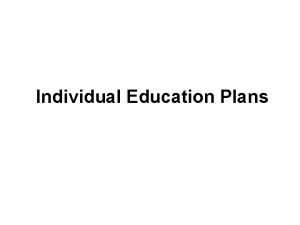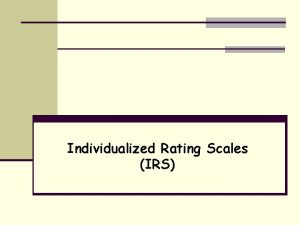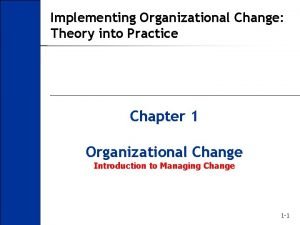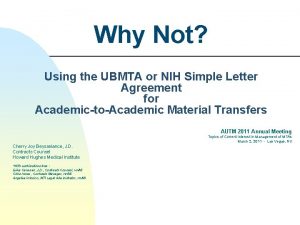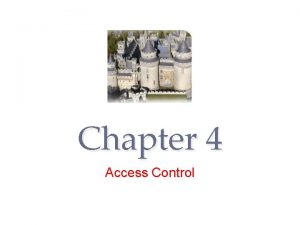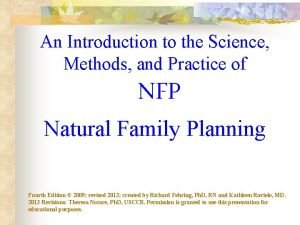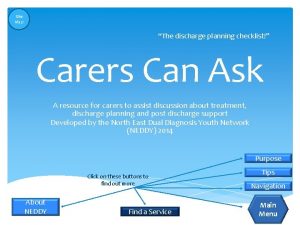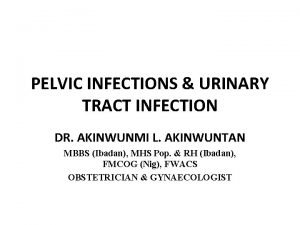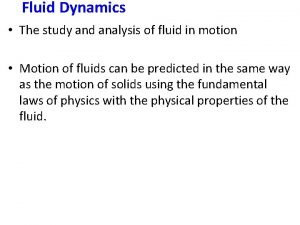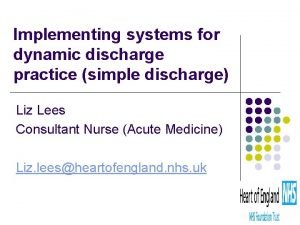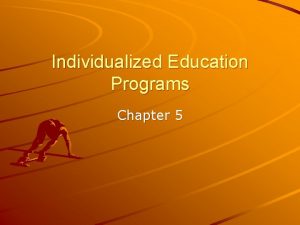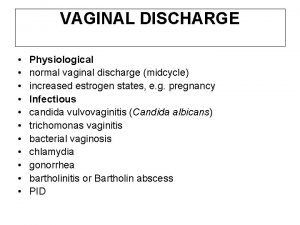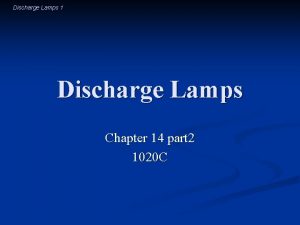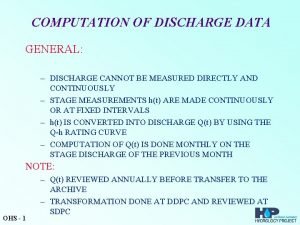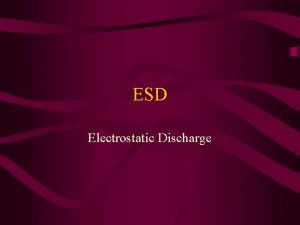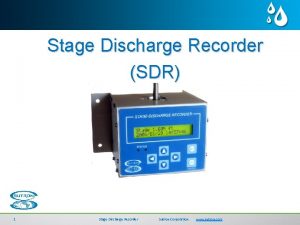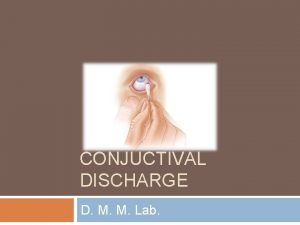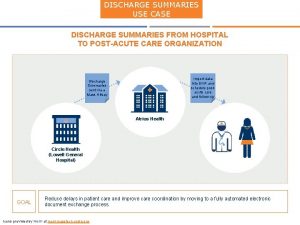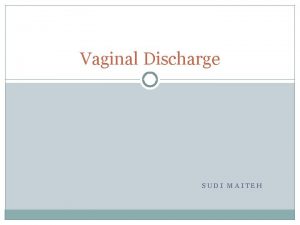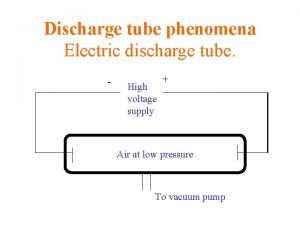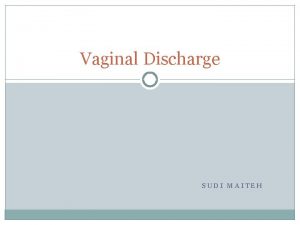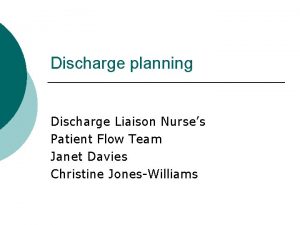Implementing an Individualized Discharge Teaching Module at a











































- Slides: 43

Implementing an Individualized Discharge Teaching Module at a Critical Access Hospital: An Evidence Based Project leader: Kelly Tiffany, BAN, FNP-s Project advisor: Susan Clouse Smith, DNP, APRN, PNP, FNP-BC Faculty consultant: Jenna Herman, DNP, APRN, FNP-BC

Thank You! The DNP project could not have been completed without the assistance of … Dr. Susan Clouse Smith Dr. Jenna Herman Dr. Billie Madler Jodi Atkinson Karla Spence Jen Laukner Katie Tofteland Alfred Sams Chassidy Sharp

Problem Statement • Poor comprehension of discharge instructions common • Disconnect between patient understanding and comprehension • Disconnect may result in – Medication errors – Misunderstanding – Patient dissatisfaction – Hospital readmissions

Organizational Needs Assessment Resources to help elderly stay in their homes Discharge education lacked: • Diagnosis specific information • Needed documentation • Evaluation of patient comprehension Low readmission rate Room for improved HCAHPS scores

SWOT Analysis • Size • Willingness • Outpatient setting • Slow to change Strengths Weaknesses Opportunities Threats • Lack of buy in

Proposed Solution • DNP project focused on patient discharge education and comprehension • DNP project setting of a CAH • Multiple interventions

PICO “Among adult acute, observational, and skilled swing bed patients in a critical access hospital, how does the implementation of an individualized discharge teaching module, as compared to the organization’s current established discharge teaching module, impact readmission rates and patient satisfaction? ”

Literature Review Transitional Interventions Guidelines Communication Barriers Discharge Planning Discharge Teaching

Knowledge Gap Literature is replete with information on… • Reducing readmissions in large organizations • Reducing readmissions for CHF & acute MI • Discharge or patient education Limited resources regarding… • Reducing readmissions in rural or critical access hospitals (CAHs) • Discharge or patient education in rural or CAHs

Theoretical Framework “The Important Elements of Effective Discharge Teaching” (IEEDT) Assessment Individualization Evaluation & Reflection Motivation & Self Efficacy (Mc. Bride & Andrews, 2013)

Recommendations By November, 2017 1. Educate on three main diagnoses of admissions: Øpneumonia Øurinary tract infections Øchronic obstructive pulmonary disease 2. Educate on and implement the Ask Me 3 program into the organization

Recommendations By November, 2017 3. Educate and implement the “teach back” method 4. Develop and implement individualized patient centered discharge instruction (PCDI)

Determinants of Change • • • Motivated team Receptive environment Involvement of physicians or providers Involvement of nursing staff A timeline or plan Image retrieved from https: //vijeydhinesh. wordpress. com/

Change Theory (Image retrieved from https: //vijeydhinesh. wordpress. com/)

Implementation Planning

Outcome Planning Milestones Critical Events Project proposal Patient education revision Creation of PCDI Implementation of Ask Me 3 Completion of project IRB approval Completion of staff education Implementation of all recommendations

1. Educate on three main diagnoses • Power. Point presentation • Revision of discharge education on the diagnoses • Material printed • Pre & post knowledge evaluation

2. Educate on and implement Ask Me 3 program • Video provided by Institute for Healthcare Improvement (IHI) for staff and patients • Ask Me 3 materials printed • Posters displayed • Pre & post knowledge evaluation

Example of Revised Education

3. Educate and implement “teach back” method • 45 minute computer module • Conviction and Confidence Scale • Pre & post knowledge evaluation

4. Develop and implement PCDI • Ask Me Three Assessment • Build and implement into electronic medical record • Retrospective chart review


Plan for Staff • Attend one of the four scheduled educational sessions • Complete interactive computer module independently • Initiate all interventions during implementation

IRB Process • End of July 2017: IRB Part 1 -4 submitted for DNP project chair review • August 1, 2017: Submitted to Chair of Graduate Nursing • October 13, 2017: Final draft submitted to Chair of Graduate Nursing • November 14, 2017: IRB approval

Evaluation Plan • • • Pre & post knowledge evaluations Conviction and Confidence Scale Retrospective chart review Readmission rates Patient satisfaction scores

Human Protections • • Human participants: DNP project setting staff Staff fully aware of DNP project No written consent obtained Ensured no identifying data on evaluations

Timeframes • DNP project implementation – January 15 th-April 9 th (12 weeks during) – October 23 rd-January 14 th (12 weeks prior) • HCAHPS scores reported quarterly – 4 th quarter 2017 (October, November, December) – 1 st quarter 2018 (January, February, March)

Influencing Factors Threats & Barriers • Challenge of staff education • CEO excitement • Time of year Facilitators • Timing of educational sessions • DNP setting size • Openness • CEO excitement

Stakeholder Involvement • Karla Spence, DON: Main resource, communicator, staff updater • Jen Laukner, Assistant Nurse Manager: Report generator • Katie Tofteland, Informatics Nurse: Electonic medical record guru • Jodi Atkinson, CEO: Informant and cheerleader

Monitoring the DNP Project • • Visited DNP site every 2 -3 weeks Written communication every 2 -3 weeks Monitored staff compliance Followed up face to face or through written communication

Education Evaluation Results • Significant increase in knowledge – “teach back” education – Ask Me 3 presentation – As evidenced by a p < 0. 001

“Teach back” Evaluation Results Conviction & Confidence 0 months 3 months Scale (N=21) (N=7) Mean Standard Deviation Conviction 9. 29 0. 956 8. 43 1. 397 Likert scale 1=not at all important 10=very important Confidence 8. 10 1. 609 8. 29 0. 951 Likert scale 1=not at all confident 10=very confident

Staff Compliance Results Retrospective Chart Review #1 Education on diagnosis Written education materials documented as given Patient education documented on each day #2 Ask Me 3 program handout given #3 “teach back” documentation #4 PCDI utilization N=60 72. 0% 58. 3% Day 1 50. 0% Day 2 38. 3% Day 3 100. 0% 65. 0% 70. 0%

3 Main Diagnoses Diagnosis 28. 3% Written education documented given 82. 4% COPD 6. 7% UTI Other 3. 3% 61. 7% CAP N=60 Teach back documented N 76. 5% 17 75% 4 50% 67. 6% 100% 56. 8% 2 37

Main Outcomes Hospital Readmission Rates • Readmission rates were essentially unchanged.

Main Outcomes

Unintended Consequences • Desire to implement Ask Me 3 on outpatient side • Patient education need for comfort care patients/families • Compliance rate lower on observation patients • Staff nurse to continue with her own master’s project

Interpretation • • Patient care improved Patient satisfaction scores increased Findings are transferable Project was cost effective

Project Revisions • Change or eliminate observation and swing bed accounts • Gather demographics on the participants • Use the “teach back” observation tool

Dissemination • Nursing and Medical staff at DNP setting – Monthly meeting in May 14 th & 16 th • Community Members – Health Fair May 7 th • Leaders of CAHs – North Dakota Critical Access Hospital Quality Network • Colleagues and Peers – Colloquium April 27 th & ND Center for Nursing 4 th Annual Conference

Conclusion & Recommendations • DNP setting staff willing to implement interventions • Patients reported higher satisfaction scores • Interventions could be implemented in outpatient settings

References • Center for Theory of Change. (2016). What is theory of change? Retrieved from https: //www. theoryofchange. org/what-is-theory-of-change/ • Grol, R. , Wensing, M. , Eccles, M. , and Davis, D. (Eds. ). (2013). Improving patient care: The implementation of change in clinical practice. (2 nd Edition). Hoboken, NJ: Wiley-Blackwell. • Image on slide 14 retrieved from https: //vijeydhinesh. wordpress. com/ • Institute for Healthcare Improvement (IHI). (2018). Always use teach back! Retrieved from http: //www. ihi. org/resources/Pages/Tools/Always. Use. Teach. Back!. aspx • Mc. Bride, M. and Andrews, G. J. (2013). The transition from acute care to home: A review of issues in discharge teaching and a framework for better practice. Canadian Journal of Cardiovascular Nursing, 23(3), 18– 24. • National Guideline Clearinghouse (NGC). (2014). Care transitions. Retrieved from https: //www. guideline. gov.

References • National Guideline Clearinghouse (NGC). (2012). Transitional care. In: Evidence-based geriatric nursing protocols for best practice. Retrieved from https: //www. guideline. gov • National Patient Safety Foundation. (n. d. ). Ask me 3: Good questions for your good health. Retrieved from http: //www. npsf. org/? page=askme 3 • Nursing Theories. (2011). Change theory. Retrieved from http: //www. currentnursing. com/nursing_theory/change_theory. ht ml • Reavy, K. (2016). Inquiry and Leadership A Resources for the DNP Project. (1 st Ed. ). Philadelphia, PA: F. A Davis Company.
 Peter g schultz
Peter g schultz Individualized education plan
Individualized education plan Individualized healthcare
Individualized healthcare Individualized consideration
Individualized consideration Individualized rating scale
Individualized rating scale Steve jobs transformational leadership
Steve jobs transformational leadership Individualized family service plan example
Individualized family service plan example Differentiated instruction vs individualized instruction
Differentiated instruction vs individualized instruction Center for individualized medicine
Center for individualized medicine C device module module 1
C device module module 1 Teaching and assessment of grammar module 1
Teaching and assessment of grammar module 1 What is scaled down teaching
What is scaled down teaching Designing and implementing brand marketing programs
Designing and implementing brand marketing programs Nfpa 1600 business continuity programs
Nfpa 1600 business continuity programs Challenges of implementing predictive analytics
Challenges of implementing predictive analytics Tripod pricing strategy
Tripod pricing strategy Implementing nfpa 1600 national preparedness standard
Implementing nfpa 1600 national preparedness standard Simplified scoring model in project management
Simplified scoring model in project management Principle of portfolio assessment
Principle of portfolio assessment Implementation of hrd program
Implementation of hrd program Zpf cisco
Zpf cisco Bert spector
Bert spector Retail management notes doc
Retail management notes doc Implementing organizational change theory into practice
Implementing organizational change theory into practice Implementing strategies management and operations issues
Implementing strategies management and operations issues Planning and implementing crm projects
Planning and implementing crm projects Implementing strategies management and operations issues
Implementing strategies management and operations issues Implementing strategies management and operations issues
Implementing strategies management and operations issues Mis issues in strategy implementation
Mis issues in strategy implementation Toyota brand hierarchy
Toyota brand hierarchy Ubmta implementing letter
Ubmta implementing letter Toyota brand architecture
Toyota brand architecture Qsen competencies teamwork and collaboration
Qsen competencies teamwork and collaboration Implementing strategies: management and operations issues
Implementing strategies: management and operations issues Implement strategies management issues
Implement strategies management issues Access rights definition
Access rights definition Ovarian cyst bleeding
Ovarian cyst bleeding Chapter 10 discharge
Chapter 10 discharge White cottage cheese discharge
White cottage cheese discharge Fertile discharge
Fertile discharge Mental health discharge planning checklist
Mental health discharge planning checklist Eitology
Eitology L
L What is discharge fluid mechanics
What is discharge fluid mechanics

